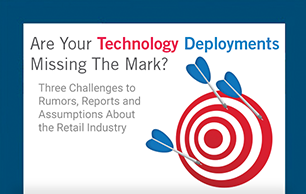 The speed of adoption of transformational technology in retail turned into a sprint during the global pandemic as retailers looked for different ways to sell and shoppers looked for different ways to buy. The pandemic expedited technology adoption by approximately 25 times, according to McKinsey. Over the last two and a half years, the sprint has turned into a marathon, but we’re running extended distances at the same sprint pace. With that kind of pressure, there’s bound to be some pain along the way.
The speed of adoption of transformational technology in retail turned into a sprint during the global pandemic as retailers looked for different ways to sell and shoppers looked for different ways to buy. The pandemic expedited technology adoption by approximately 25 times, according to McKinsey. Over the last two and a half years, the sprint has turned into a marathon, but we’re running extended distances at the same sprint pace. With that kind of pressure, there’s bound to be some pain along the way.
I have participated in countless discussions, panels and customer conversations, debating the challenges of successful integration of Artificial Intelligence (AI) and use cases that support business objectives. The power of AI sets it apart from other legacy technologies that were designed to accomplish a single designated objective as, by its very nature, AI learns and improves over time and can evolve to support the changing needs of the business. Very often, the challenges we see related to AI deployment stem from businesses not fully understanding the power of AI to support different aspects of the business, from better customer service to back-end operations, security and sustainability. In a world where technology leaders are accustomed to “point solutions” that address individual business problems that can be planned and measured, getting comfortable with intelligent computing that can learn and address a variety of challenges, can take some getting used to.
For example, a number of AI deployments in retail started off at the self-checkout (SCO). This is where Everseen started with our visual AI solution for SCOs. The initial objective was to identify and alert personnel if a customer (accidentally or deliberately) bagged an item without scanning it or scanned a lower-cost item beneath a more expensive item. With the right computer vision, the system can do this, but the thinking is too small if that’s all it does. Once the AI solution is deployed, the situation either changes or the retailer sees a better, more extensive way to use the solution. Instead of just flagging a particular transaction and alerting personnel, what if the solution nudged the customer and showed the proper way to scan, correcting mis-scans without personnel involvement and confrontation? Or what if AI could be used to alert managers when known shoplifters enter the store so losses can be averted before the thief reaches the final step before checkout?
Retailers have not yet realized the full potential of what all AI can do. Certainly, a number of different use cases are being explored but, too often, retailers are only seeing the tip of the iceberg. Here are some tips for maximizing AI to increase revenue, reduce costs, and mitigate risk.
- Think big – Think about business problems broadly rather than point solutions to benefit from the broadest use of AI. For example, is the objective to stop the mis-scan of an item at the checkout or is the objective to reduce loss?
- Experimentation is key – We’re pioneering new territory with these emerging technologies. It’s ok to try something and fail. The key is to fail fast and keep moving forward. Learn from your mistakes and move on to the next use case.
- Start where the money is – The possibilities for AI are virtually endless. Start where the money is to generate the greatest ROI. Loss may be an issue, but what if you could reduce friction and leverage AI to increase throughput?
- Choose well-connected solution providers – Everseen is just one part of the equation for a successful visual AI deployment. Cameras, hardware and infrastructure are all required for success. Choose well-connected solution providers with proven integrations to ensure the project is a success.
If you’d like to hear more about AI in retail, listen to the Telaid Tech Connect podcast where Beth Bergmann and I talk about operationalizing AI and what we’re learning from actual marketplace deployments. If you want to see a demo of our visual AI solutions, reach out to me and our team would be happy to show you our technology in action!




